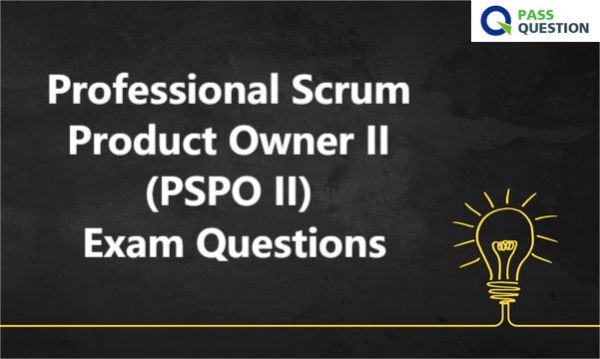Professional Scrum Product Owner II (PSPO II) Exam Questions
In order to help you pass the Professional Scrum Product Owner II (PSPO II) Exam, PassQuestion created Professional Scrum Product Owner II (PSPO II) Exam Questions that will help you clear Scrum PSPO-II test on your first attempt. You will have to use our Professional Scrum Product Owner II (PSPO II) Exam Questions multiple times so you can ensure your success in the real exam. It will provide you a real exam scenario so you can get a better idea of how you can prepare for the PSPO II exam. It is the right way to proceed so you can clear your Professional Scrum Product Owner PSPO II exam on the first attempt.

Professional Scrum Product Owner II (PSPO II) Exam
The Professional Scrum Product Owner II (PSPO II) certification validates your understanding of advanced Professional Scrum Product Ownership, the Scrum framework and delivering valuable products. When taking PSPO II, you should have experience as a Product Owner and a strong understanding of the fundamentals of Scrum. PSPO II tests your knowledge of Scrum, Product Ownership, delivering value and how you would handle real-world situations.
Exam Information
$250 USD per attempt
Passing score: 85%
Time limit: 60 minutes
Number of Questions: 40 (partial credit provided on some questions)
Format: Multiple Choice, Multiple Answer
Exam Topics
Understanding and Applying the Scrum Framework:
Empiricism, Scrum Values, Scrum Team, Events, Artifacts, Scaling
Managing Products with Agility:
Forecasting & Release Planning, Product Vision, Product Value, Product Backlog Management, Business Strategy, Stakeholders & Customers
Evolving the Agile Organization:
Organizational Design & Culture, Portfolio Planning, Evidence Based Management
View Online Professional Scrum Product Owner II (PSPO II) Free Questions
1. What is the value of a Product Owner having a clear and inspiring Product vision? (choose the best three answers)
A. It provides a direction and purpose for the product.
B. It makes it easier to inspect progress
C. It ensures that the Scrum Team is committed to deliver all of the Product Backlog items.
D. It is not defined in Scrum and therefore optional.
E. It provides a focus when making decisions
Answer: A,B,E
2. How should multiple Scrum Teams, working together on the same product, select the Product Backlog Item for their teams? (choose the best answer)
A. The Product Owner proactively assigns the Product Backlog Item to each team.
B. The Developers pull in work in agreement with the Product Owner.
C. The Scrum Team with the highest velocity is prioritized to pick up the Product Backlog Item first.
D. Share the number of the Product Backlog Item equally to all teams.
Answer: B
3. Which of the following are considered preferred Product Owner stances? (choose all that apply)
A. The Story Writer
B. The Decision Maker
C. The Collaborator
D. The Visionary
E. The Subject Matter Expert
Answer: B,C,D
4. Who is allowed to make changes in the Product Backlog? (choose the best two answers)
A. Anyone.
B. The Product Owner
C. The Key Stakeholders
D. The Developers, in agreement with the Product Owner.
Answer: B,D
5. When determining the ordering of an item on the Product Backlog, what are some things a Product Owner should consider? (choose all that apply)
A. Alignment with business strategy and goals
B. Importance to customers
C. The complexity of developing the Product Backlog Item
D. Risk
E. Alignment and dependencies with existing Product Backlog items
Answer: A,B,C,D,E
6. What is TRUE about the Stakeholder's role in Scrum? (choose the best answer)
A. The Product Owner is responsible for engaging with the Stakeholders, but can be delegated
B. The Scrum Master schedules all stakeholder interactions.
C. The Business Analyst (Subject Matter Experts) is responsible for engaging with the Stakeholders and collecting requirements for the Product Owner
D. The Head of Product represents the Stakeholder needs and is the point of contact for product requirements
E. Only the Developers can engage with the Stakeholders
Answer: A
- TOP 50 Exam Questions
-
Exam
All copyrights reserved 2025 PassQuestion NETWORK CO.,LIMITED. All Rights Reserved.

